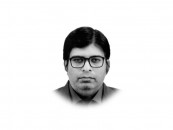Have we achieved our poverty MDGs?
Annual Plan 2013-14 says Pakistan has achieved MDG1 before the 2015 deadline. However, this is too good to be true.

pervez.tahir@tribune.com.pk

In taking stock of the progress towards achieving the MDGs, the recent report by the secretary general of the United Nations does say that MDG 1 has been achieved at the global level. In the case of Pakistan, however, this is too good to be true. The benchmark poverty rate was 26.1 per cent in 1990-91, during the tenure of the first PML-N government. It was to be brought down to 13 per cent by 2014-15.
According to the Annual Plan 2013-14, however, the incompetent PPP regime succeeded in slashing 12.9 per cent in 2010-11, which is four years ahead of the target year. At this rate of progress, poverty should have been completely eradicated by now. Has it been? You have only to step out of your house and the ugly face of poverty, inequality and unemployment becomes immediately visible. Moreover, public perception and some individual research suggest that poverty has been on the rise.
The claim in a document released by the PML-N government had never been made by the outgoing PPP government, which, out of sheer embarrassment, stopped publishing official poverty numbers. Pakistan had not notified an official poverty line until 2001. In that year, an official poverty line, based on a caloric norm of 2,350 calories per adult per day — 2,150 for urban residents and 2,450 for rural residents — was adopted. A minimum of non-food requirements was added. The line approximated to Rs673.54 per month per adult, equal to what it was in 1998-99 and Rs748.56 in 2000-01.
To facilitate comparisons with existing measures, the Planning Commission estimated a series from 1986-87 to 2000-01 based on the Household Income and Expenditure Survey data. According to these estimates, national poverty declined between 1987-88 and 1993-94. In this period, rural poverty was lower than urban poverty. Since 1996-97, poverty began to rise again, with the difference being that rural poverty was now higher than urban poverty. The ratio of poverty in 2000-01 was estimated at 32.1 per cent.
This year was redesignated as 2001-02 with a higher poverty ratio of 34.5 per cent. A change of database had occurred at this time. Pakistan had started conducting its own Household Income and Expenditure Surveys — renamed later as Household Integrated Economic Survey (HIES) — since 1963. These surveys were carried out periodically until 1996-97. On the advice of the UK-based Department for International Development, the HIES was merged into the Pakistan Integrated Household Survey (PIHS) in 1998-99. The 2000-01 estimate of poverty was based on the PIHS. Later, as part of the Poverty Reduction Strategy Paper process supported by international financial institutions, the Pakistan Social and Living Standard Measurement (PSLSM) was launched, with HIES as a subset. The results of the first PSLSM in 2004-05 were used to estimate poverty, placing the ratio at a low level of 23.9 per cent. To provide a benchmark, the year 2001-02 was shown to have a higher poverty ratio of 34.5 per cent, implying a poverty reduction of 10.6 percentage points in such a short period. This number, as well as the survey, has become controversial. In 2004-05, the survey seems to have been manipulated to ensure a downward bias.
Published in The Express Tribune, August 2nd, 2013.
Like Opinion & Editorial on Facebook, follow @ETOpEd on Twitter to receive all updates on all our daily pieces.














COMMENTS
Comments are moderated and generally will be posted if they are on-topic and not abusive.
For more information, please see our Comments FAQ